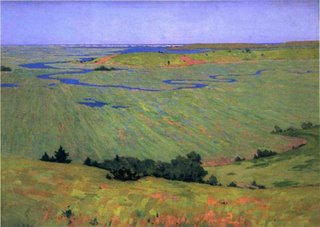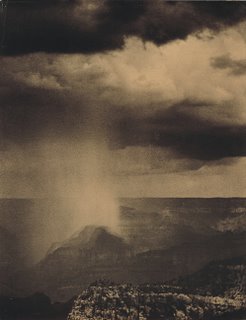the new math
 we've already looked at dow's moment of epiphany, the realization that what he had been looking for was the book of hokusai prints right there in his hands. let's look a little closer:
we've already looked at dow's moment of epiphany, the realization that what he had been looking for was the book of hokusai prints right there in his hands. let's look a little closer:dow has now met ernest fenollosa, and is studying with him at any possibility.
"In May, Fenollosa, with a certain flair he had for the dramatic, opened a door and showed Dow two magnificent screens by Okio. Dow looked at them in silence for a space and then exclaimed, 'Why can't I do that?' (The subject was a pine covered with snow.)
the clarity of his vision was such that he went on to formulate, and to develop ways of teaching these insights to others, work that some say became more important than making art itself. he is credited for having changed the way art is regarded and taught in this country radically, and his methods were the staple of american art education for many years.
 i went to the jung pages and apparently the descriptive phrase i wanted to use, 'collective unconscious,' doesn't actually mean what i have always taken it to mean, so that won't work, unless i am allowed to redefine (or expand its definitions) the concept to what i always thought it meant and what fits in rather well here, namely that there is some mysterious (until science figures it out) connection of every human's mind that rises and falls with the tide and explains how one idea can occur in many places at the same time.
i went to the jung pages and apparently the descriptive phrase i wanted to use, 'collective unconscious,' doesn't actually mean what i have always taken it to mean, so that won't work, unless i am allowed to redefine (or expand its definitions) the concept to what i always thought it meant and what fits in rather well here, namely that there is some mysterious (until science figures it out) connection of every human's mind that rises and falls with the tide and explains how one idea can occur in many places at the same time. artists throughout the west were paring down, simplifying, following ideas they had imbibed from the japanese prints; did each and every one of them feel themselves to be a solitary traveler?
artists throughout the west were paring down, simplifying, following ideas they had imbibed from the japanese prints; did each and every one of them feel themselves to be a solitary traveler? it's such an interesting phenomenon-- i wish i knew the name for it.
it's such an interesting phenomenon-- i wish i knew the name for it.when things change, we each want to name it, to own it, and to think we know the reason why.
Labels: alvin coburn, arthur wesley dow, charles guilloux, emil orlik, fenollosa, frances gearhart, hannah borger overbeck, harry fenn, henri riviere, Max Laeuger, maxime maufra, newcomb, okio, pedro de lemos, s bing




































